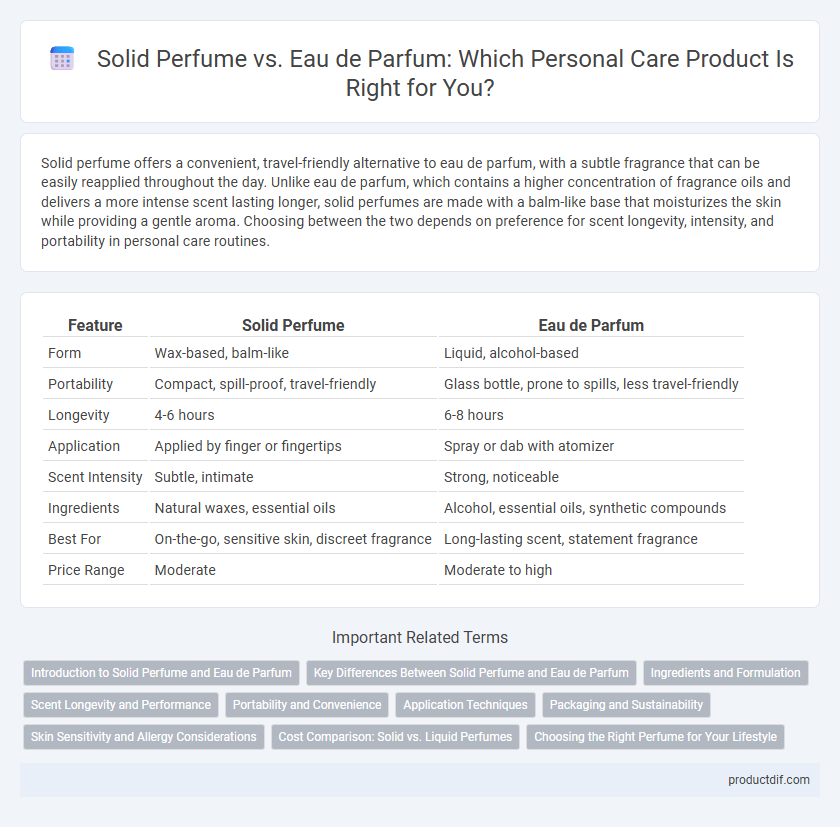Solid perfume offers a convenient, travel-friendly alternative to eau de parfum, with a subtle fragrance that can be easily reapplied throughout the day. Unlike eau de parfum, which contains a higher concentration of fragrance oils and delivers a more intense scent lasting longer, solid perfumes are made with a balm-like base that moisturizes the skin while providing a gentle aroma. Choosing between the two depends on preference for scent longevity, intensity, and portability in personal care routines.
Table of Comparison
| Feature | Solid Perfume | Eau de Parfum |
|---|---|---|
| Form | Wax-based, balm-like | Liquid, alcohol-based |
| Portability | Compact, spill-proof, travel-friendly | Glass bottle, prone to spills, less travel-friendly |
| Longevity | 4-6 hours | 6-8 hours |
| Application | Applied by finger or fingertips | Spray or dab with atomizer |
| Scent Intensity | Subtle, intimate | Strong, noticeable |
| Ingredients | Natural waxes, essential oils | Alcohol, essential oils, synthetic compounds |
| Best For | On-the-go, sensitive skin, discreet fragrance | Long-lasting scent, statement fragrance |
| Price Range | Moderate | Moderate to high |
Introduction to Solid Perfume and Eau de Parfum
Solid perfume offers a concentrated fragrance in a wax-based formula that provides longer-lasting scent with easy, mess-free application, ideal for on-the-go use. Eau de parfum contains a higher concentration of aromatic compounds, typically 15-20%, delivering a more intense and longer-lasting fragrance experience through spritzing. Both forms present unique benefits in personal care, with solid perfumes excelling in portability and subtlety, while eau de parfums provide richer olfactory profiles suited for extended wear.
Key Differences Between Solid Perfume and Eau de Parfum
Solid perfume offers portability and subtle fragrance intensity with a wax-based formula that lasts for approximately 2 to 4 hours, ideal for on-the-go touch-ups. Eau de parfum contains a higher concentration of aromatic compounds, typically 15-20%, providing a longer-lasting scent of 6 to 8 hours with a more pronounced projection. The application method also differs: solid perfume is applied via fingertips allowing precise control, whereas eau de parfum is sprayed evenly over pulse points for broader diffusion.
Ingredients and Formulation
Solid perfume features a blend of natural waxes, oils, and concentrated fragrance oils, creating a thicker, balm-like texture that adheres softly to the skin and offers a subtle scent release. Eau de parfum contains a higher concentration of aromatic compounds dissolved in alcohol and water, resulting in a more intense fragrance projection and longer-lasting wear. The formulation differences impact application methods, with solid perfumes being ideal for targeted, discreet use and eaux de parfum suited for broader, more pronounced scent diffusion.
Scent Longevity and Performance
Solid perfume offers a more subtle scent release that lasts around 3 to 4 hours, ideal for close-contact fragrance experiences. Eau de parfum, with higher concentration of aromatic compounds (typically 15-20%), delivers a stronger, longer-lasting scent that can persist up to 8 hours or more on the skin. Performance-wise, eau de parfum is more suitable for all-day wear, while solid perfume provides convenient, discreet reapplication throughout the day.
Portability and Convenience
Solid perfume offers superior portability due to its compact, spill-proof design, making it ideal for on-the-go touch-ups. Eau de parfum, while typically longer-lasting and more intense in fragrance, comes in fragile glass bottles that limit ease of transport. Users seeking convenience and mess-free application often prefer solid perfume for daily carry.
Application Techniques
Solid perfume is applied by gently rubbing a small amount onto pulse points, such as wrists and neck, allowing the fragrance to blend with body heat for a subtle scent. Eau de parfum is typically sprayed from a distance onto pulse points, distributing a more intense and longer-lasting aroma. The solid format offers on-the-go touch-ups without the risk of over-application, while eau de parfum delivers a more pronounced scent experience.
Packaging and Sustainability
Solid perfume packaging minimizes plastic waste through compact, reusable containers made from metal or glass, promoting eco-friendly personal care. Eau de parfum typically uses heavier glass bottles with plastic components, increasing environmental impact and carbon footprint during production and disposal. Choosing solid perfume supports sustainable practices by reducing packaging volume and encouraging refillable designs, aligning with zero-waste beauty trends.
Skin Sensitivity and Allergy Considerations
Solid perfume typically contains fewer synthetic chemicals and alcohol, making it gentler on sensitive skin and reducing the risk of irritation and allergic reactions. Eau de parfum often includes higher concentrations of alcohol and fragrance oils, which can cause dryness and trigger allergies in individuals with sensitive skin. Choosing solid perfume is ideal for those prone to skin sensitivity, as its natural, moisturizing ingredients provide a safer alternative.
Cost Comparison: Solid vs. Liquid Perfumes
Solid perfumes generally cost less to produce and purchase than eau de parfum due to lower alcohol content and simpler packaging. Eau de parfum involves higher concentrations of fragrance oils and alcohol, increasing both manufacturing expenses and retail prices. Consumers often find solid perfumes more budget-friendly for daily use without compromising scent longevity.
Choosing the Right Perfume for Your Lifestyle
Solid perfume offers a compact, travel-friendly option with subtle scent release, ideal for on-the-go touch-ups and sensitive skin due to its natural ingredients and lack of alcohol. Eau de parfum delivers a longer-lasting and more intense fragrance experience, suiting those who prefer bold scents and extended wear throughout busy days. Selecting between solid perfume and eau de parfum depends on lifestyle factors such as scent longevity, portability, and skin sensitivity preferences.
Solid perfume vs Eau de parfum Infographic

 productdif.com
productdif.com